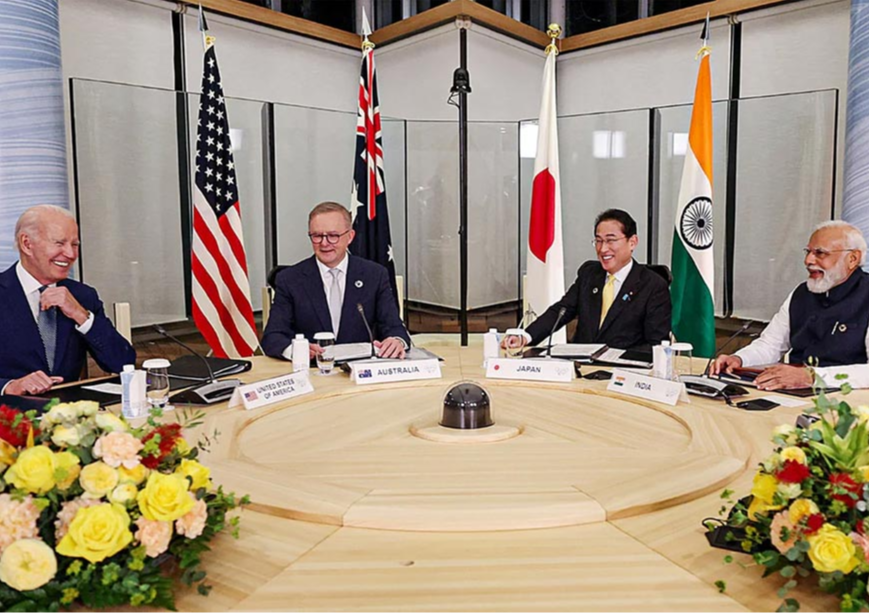
In the backdrop of China’s grey-zone coercion tactics against the Philippines, the recent meeting of defense ministers of the United States, Japan, Australia, and the Philippines underscored a new Pacific deterrence imperative: the Squad. For some, the development projects the Quad in a paler light, given its hitherto role as the pre-eminent regional minilateral initiative to balance China. The Quad is often perceived as an organisation with largely a public goods provision mandate. The Squad may have brought a security paradigm in the picture that the Quad lacks.
The question whether the Quad should be militarised has been debated ad nauseam and now seems nudged by the ‘Squad’ proposition.
Strategic autonomy
The narratives around possible militarisation of the Quad have traditionally involved two frames; the first concerns China’s growing influence in the Indo-Pacific and the second, India being its ‘weakest link’. Both the persuasion and the critique seem to converge should the Quad, indeed, were to add a military purpose. From India’s perspective, the desire to avoid a military alliance in the region is preeminent. However, divergent interests within the group and threat perception of other Quad members sometime overshadow that concern conceptually. Besides, the China question in India’s national discourse continues to grow starker. India has not only increased footprints in the South China Sea but has openly backed the Philippines’s rights to operate freely against Chinese harassment and counter-claims of sovereignty which is at odds with the 2016 decision of the Permanent Court of Arbitration.
India’s reluctance to embrace a militarised Quad is rooted in its pursuit of strategic autonomy as the appropriate foreign policy approach. This deep-rooted origins of the suspicion of alliance politics among India’s strategic elites perhaps dates back to the nationalist opinion in interwar years which saw imperial competition, alliance chain-ganging, and arms race as responsible for the misery of World War I. The consequent pursuit of a non-aligned foreign policy paid reasonable dividends in the post-independence years as India mostly faced a relaxed geopolitical environment as a preponderant power in its immediate neighbourhood, safely tucked away from the frontlines of the Cold War superpower conflict.
India’s reluctance to embrace a militarised Quad is rooted in its pursuit of strategic autonomy as the appropriate foreign policy approach.
Even so, in cases of urgent national security threats, Indian policymakers were prudent enough to quickly put to rest the shibboleths of non-alignment, with Nehru asking Kennedy for military aid in the 1962 border war, Shastri’s pursuit of extended nuclear umbrella from both superpowers in the mid-1960s, and Indira Gandhi’s de facto mutual defence treaty with the Soviet Union in 1971. While security alignments do come with the risks of entrapment and might serve to generate spirals of mistrust with an adversary, the upsides of reliance on external powers to augment own capabilities in the face of a threatening polar power warrant a serious consideration on part of India to shed its inertia and hesitancy.
Altered realities
The locations of the Chinese incursion and its disengagement pattern in the Ladakh crisis point to its intent of asserting the maximalist 1959 claim lines. Based on its actions in Ladakh and elsewhere, China can reasonably be construed as a rational security-driven actor with revisionist intentions adopting a strategy of salami slicing to present its opponents with a fait accompli. On Beijing’s part, the use of fait accompli tactic relies on the hope of preventing the adversarial response in terms of a counterbalancing coalition or an escalation of dispute into an outright war- measures entailing too high a cost for China. Further, for the most part, China has historically seen India through the prism of its relation with other great powers, refusing to treat New Delhi on equal terms. On its part, India sought a modus vivendi with China on the border in the post-Cold War years and later shifted to the strategy of evasive balancing which mixed India’s pursuit of security partnerships and ramping up of own capabilities with a reassurance policy of sending signals of its benign intentions to China.
China’s incursions in Ladakh in 2020 and its use of grey-zone coercion tactics with the Philippines, Australia, and Taiwan, however, has warranted a shift in the Indo-Pacific countries’ geopolitics. The rise of a criss-crossing web of minilaterals in the region stemmed from the need to respond to the Chinese aggression. While the security-centric minilaterals and the US military engagement in the region have deterred China from launching a major militarised conflict, the minilaterals and bilateral alignments, including a resuscitated Quad in 2017, so far have failed to deter China from instigating territorial disputes in both the continental and maritime theatres.
The rise of a criss-crossing web of minilaterals in the region stemmed from the need to respond to the Chinese aggression.
As a rational, revisionist actor that responds to external geopolitical conditions, China can be deterred by concerted efforts from the US, its allies, and like-minded partners. The Quad’s failure in deterring the Chinese ingress in Ladakh in 2020 can precisely be attributed to Beijing’s perception of India’s unwillingness to impose intolerable costs in retaliation. To put it clearly, India’s fear of stoking a spiral of mistrust with China led it to only reluctantly embrace the Quad and its Indo-Pacific partners which, in turn, emboldened China enough to launch the aggression in the hope that it won’t face punishment from the US and other nations.
Thus, to deter China by sending clear signals of resolve, the Quad needs to up its game in the conventional, hard power domain. To be sure, India has strategically engaged with other resident Indo-Pacific powers in both bilateral and minilateral formats covering the maritime and continental theatres. However, the logic of balancing efficacy of a concerted quadrilateral effort by leading regional economic powerhouses to shore up India’s position—both in terms of sending clear signals of resolve and augmenting its military capability to deal with the Chinese aggression in case of deterrence failure—warrants a serious consideration of the securitisation of the Quad.
As larger states of the region augment their offense and defence capabilities, a structural shift in the Indo-Pacific is imminent. The stakes in dealing with a revisionist China combined with its own ambitions are too high for India to stick to the usual affairs. Recently, India’s External Affairs Minister S. Jaishankar advised that India should adopt a national security filter to even business links with China. The case for adding a military dimension to the Quad, even if seemingly innocuous, wasn’t more pressing. The ‘Squad’ could shine a brighter light on that aspect of regional capacity building. It is clear that there will always be perceptive and capacity gaps between the Pacific theatre and the Indian Ocean theatre that together form the Indo-Pacific, given the presence of US alliance system and China’s immediate interests both located in the former. Yet, as India seeks a larger regional role in ensuring a free, open and inclusive Indo-Pacific, adding teeth to its capacities in a dispersed and subtle form may be in the order.
Vivek Mishra is a Fellow at the Observer Research Foundation
Sanjeet Kashyap is a Research Intern at the Observer Research Foundation
The views expressed above belong to the author(s). ORF research and analyses now available on Telegram! Click here to access our curated content — blogs, longforms and interviews.




 PREV
PREV


.png)
.png)